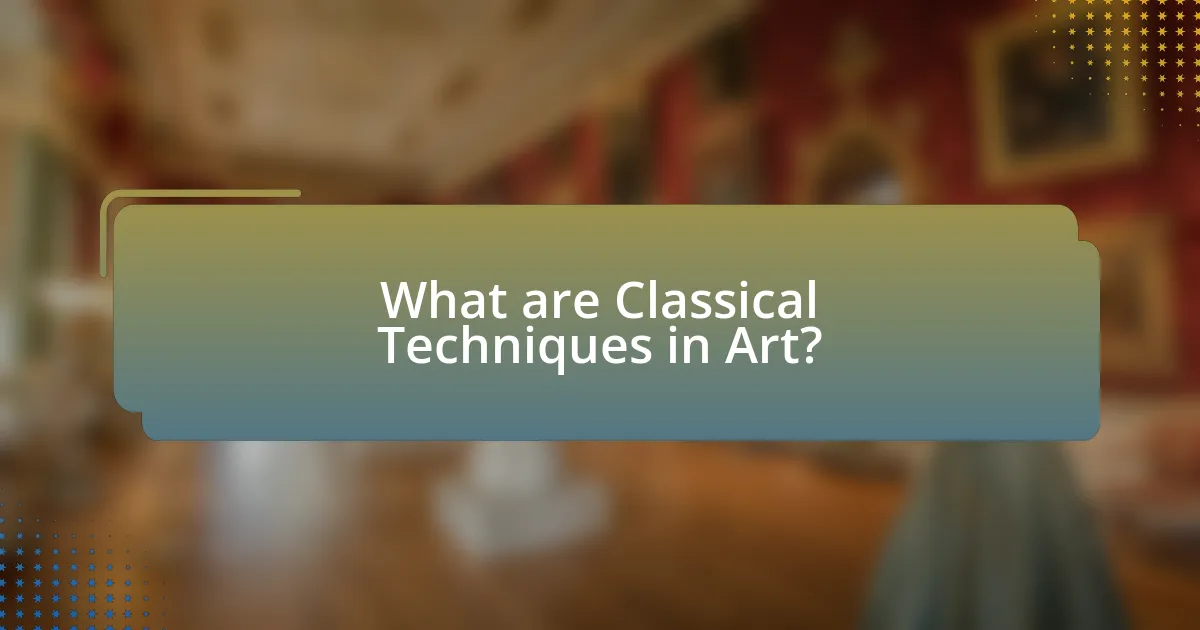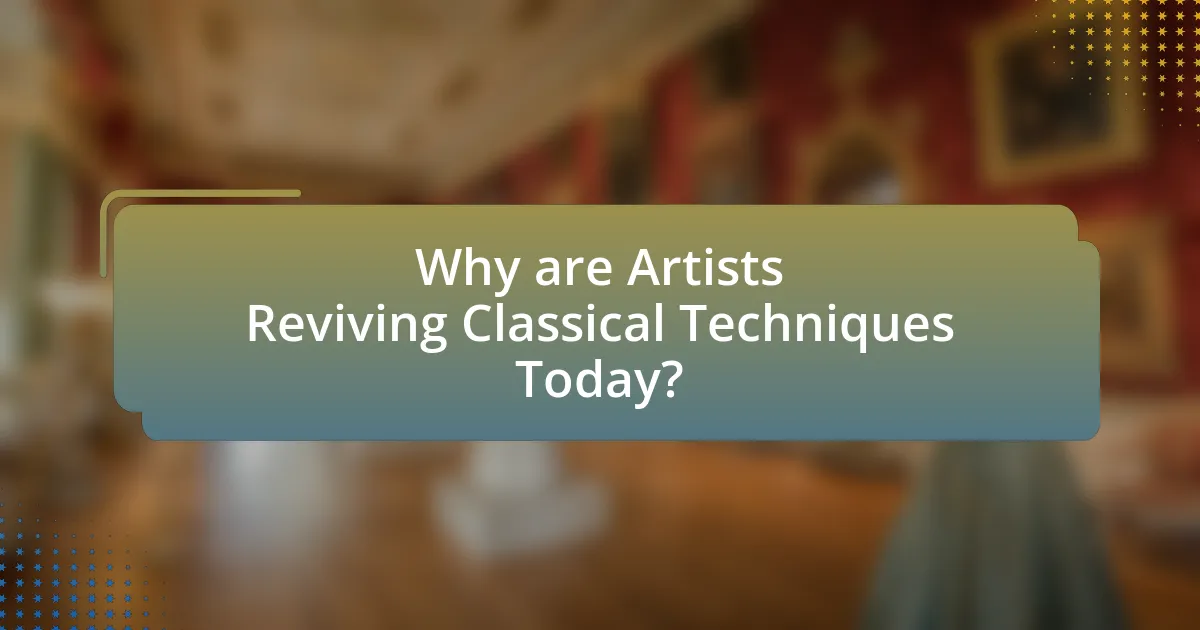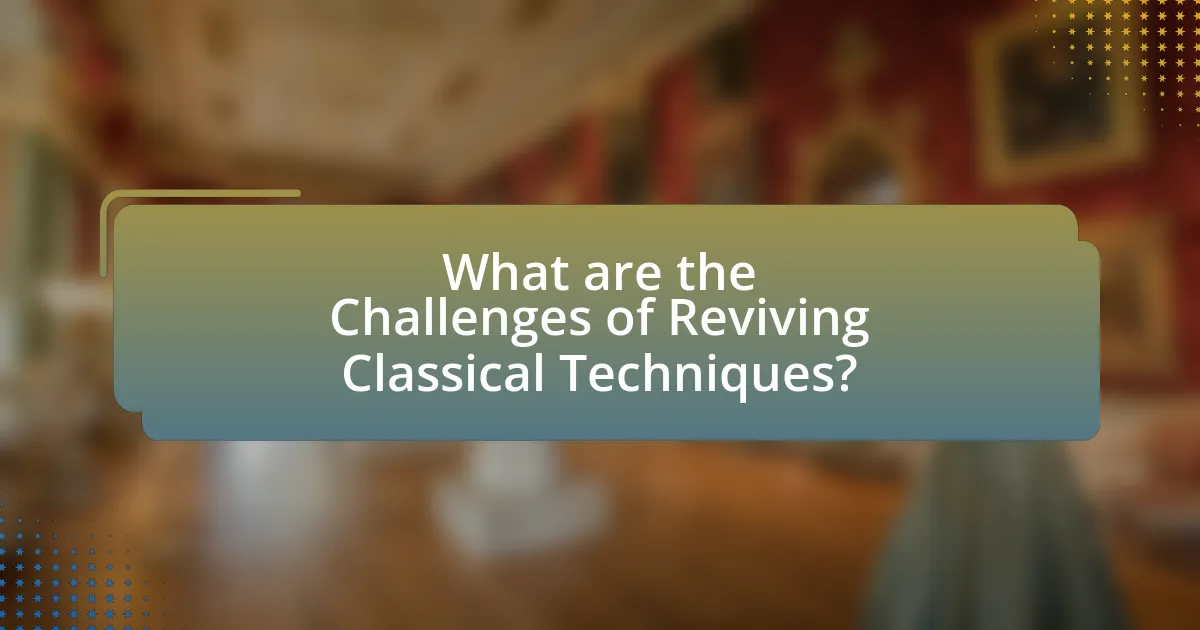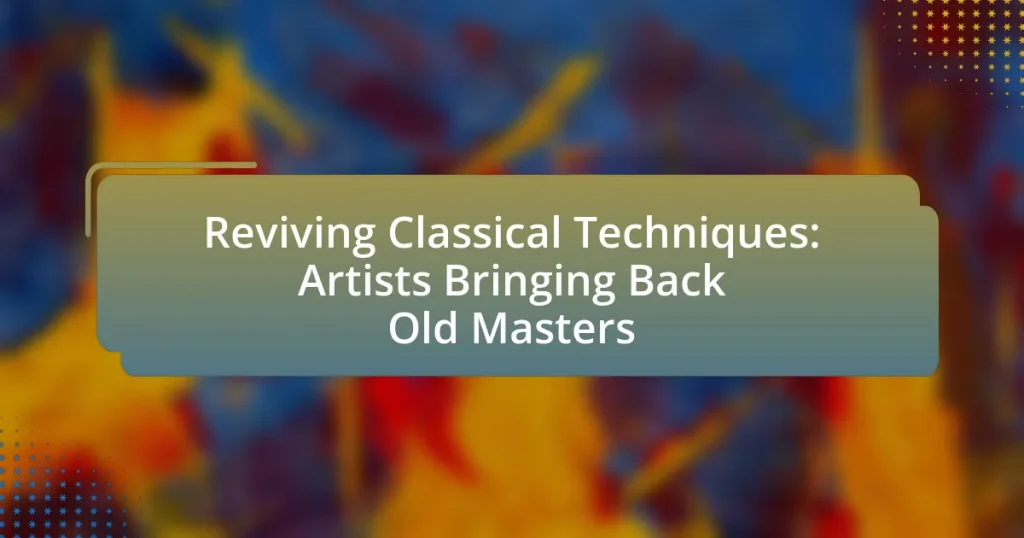Reviving Classical Techniques focuses on the resurgence of traditional art methods employed by Old Masters such as Leonardo da Vinci and Michelangelo, emphasizing realism, proportion, and perspective. The article explores the differences between classical and modern techniques, highlighting key characteristics and the historical significance of classical methods in art history. It discusses the influence of Old Masters on contemporary artists, the challenges faced in reviving these techniques, and the resources available for artists seeking to incorporate classical methods into their practice. Additionally, it addresses the benefits of blending classical techniques with modern styles and the role of mentorship and community support in this revival process.

What are Classical Techniques in Art?
Classical techniques in art refer to the traditional methods and practices used by artists from ancient Greece and Rome through the Renaissance, characterized by a focus on realism, proportion, and perspective. These techniques include the use of chiaroscuro for light and shadow, sfumato for soft transitions between colors, and linear perspective to create depth. Historical evidence shows that artists like Leonardo da Vinci and Michelangelo employed these methods to achieve lifelike representations, which have influenced countless generations of artists.
How do Classical Techniques differ from Modern Techniques?
Classical techniques differ from modern techniques primarily in their approach to materials and methods. Classical techniques often emphasize traditional mediums such as oil painting, tempera, and fresco, utilizing time-honored methods like glazing and underpainting to achieve depth and realism. In contrast, modern techniques frequently incorporate a wider range of materials, including acrylics, digital media, and mixed media, allowing for more experimental and abstract expressions. Historical context supports this distinction; for instance, the Renaissance artists like Leonardo da Vinci adhered to meticulous layering and perspective, while contemporary artists like Jackson Pollock embraced spontaneity and abstraction, reflecting a shift in artistic philosophy and cultural influences.
What are the key characteristics of Classical Techniques?
Classical techniques are characterized by their emphasis on realism, precision, and mastery of traditional methods. These techniques often involve a strong foundation in drawing, the use of chiaroscuro for depth, and a focus on anatomical accuracy in figure representation. Historical evidence shows that artists like Leonardo da Vinci and Michelangelo utilized these methods to achieve lifelike representations, which have influenced generations of artists. The adherence to these principles allows for a structured approach to art-making that prioritizes skill and technique over abstraction.
Why are Classical Techniques considered important in art history?
Classical techniques are considered important in art history because they form the foundational principles of artistic practice that have influenced countless generations of artists. These techniques, such as chiaroscuro, linear perspective, and the use of the golden ratio, were perfected during the Renaissance and are essential for understanding the evolution of visual representation. For instance, the mastery of perspective by artists like Leonardo da Vinci allowed for more realistic depictions of space and depth, which became a standard in Western art. The continued study and revival of these techniques by contemporary artists demonstrate their lasting impact and relevance in creating depth, realism, and emotional resonance in art.
What role did Old Masters play in the development of Classical Techniques?
Old Masters significantly influenced the development of Classical Techniques by establishing foundational principles in composition, perspective, and color theory. Their meticulous study of human anatomy and natural forms set standards for realism and technical skill that later artists sought to emulate. For instance, artists like Leonardo da Vinci and Michelangelo perfected techniques such as chiaroscuro and sfumato, which became essential in the training of subsequent generations. The Old Masters’ works served as critical references in art academies, where aspiring artists learned to replicate their methods, thereby ensuring the continuity and evolution of Classical Techniques throughout art history.
Who are some of the most influential Old Masters?
Some of the most influential Old Masters include Leonardo da Vinci, Michelangelo, and Rembrandt. Leonardo da Vinci is renowned for his masterpieces such as the “Mona Lisa” and “The Last Supper,” which exemplify his innovative techniques in composition and perspective. Michelangelo, celebrated for his sculptures like “David” and the Sistine Chapel ceiling, significantly impacted the portrayal of the human form and emotion in art. Rembrandt, known for his mastery of light and shadow in works like “The Night Watch,” revolutionized portraiture and narrative painting. These artists have left a lasting legacy that continues to inspire contemporary artists in reviving classical techniques.
What techniques did Old Masters commonly use in their works?
Old Masters commonly used techniques such as chiaroscuro, sfumato, and glazing in their works. Chiaroscuro involves the use of strong contrasts between light and dark to create a sense of volume and depth, as seen in the works of Caravaggio. Sfumato, a technique perfected by Leonardo da Vinci, allows for soft transitions between colors and tones, enhancing realism. Glazing, used by artists like Rembrandt, involves applying thin layers of transparent paint to create luminosity and depth. These techniques were foundational in achieving the realism and emotional depth characteristic of Old Master paintings.

Why are Artists Reviving Classical Techniques Today?
Artists are reviving classical techniques today to reconnect with traditional craftsmanship and enhance their creative expression. This resurgence is driven by a desire for authenticity and depth in art, as many contemporary artists seek to explore the foundational skills that have shaped art history. For instance, techniques such as oil painting, chiaroscuro, and classical drawing methods are being reintroduced in modern works, allowing artists to create more nuanced and textured pieces. The revival is also supported by educational institutions and workshops that emphasize classical training, reflecting a growing appreciation for the mastery of old techniques in a digital age.
What motivates contemporary artists to adopt Classical Techniques?
Contemporary artists are motivated to adopt Classical Techniques primarily to enhance their technical skills and connect with art history. By mastering these traditional methods, artists can achieve a higher level of craftsmanship, which is often seen as a response to the perceived superficiality of modern art forms. For instance, the resurgence of interest in realism and the meticulous techniques of the Old Masters, such as chiaroscuro and sfumato, allows artists to explore depth and emotion in their work. This revival is supported by art institutions and workshops that emphasize classical training, demonstrating a collective desire among artists to bridge the gap between past and present artistic practices.
How does the revival of Classical Techniques influence modern art?
The revival of Classical Techniques significantly influences modern art by reintroducing traditional methods of representation, composition, and craftsmanship. Artists today, such as Kehinde Wiley and Jenny Saville, draw inspiration from the techniques of the Old Masters, utilizing oil painting, chiaroscuro, and meticulous attention to detail to create contemporary works that resonate with historical contexts. This blending of classical methods with modern themes allows for a dialogue between past and present, enriching the narrative of contemporary art. For instance, Wiley’s portraits echo the grandeur of classical portraiture while addressing contemporary social issues, demonstrating how classical techniques can be adapted to convey modern messages.
What are the perceived benefits of using Classical Techniques in contemporary works?
The perceived benefits of using Classical Techniques in contemporary works include enhanced artistic depth, improved technical skill, and a connection to historical art traditions. Artists who incorporate these techniques often achieve a greater level of detail and realism, as seen in the works of contemporary painters like Kehinde Wiley, who employs traditional methods to create modern narratives. Additionally, utilizing classical techniques can foster a deeper appreciation for art history, allowing contemporary artists to engage with the legacies of masters such as Caravaggio and Rembrandt, thereby enriching their own creative expressions. This blend of old and new not only elevates the aesthetic quality of contemporary art but also invites dialogue about the evolution of artistic practices.
How do artists incorporate Classical Techniques into their practice?
Artists incorporate Classical Techniques into their practice by studying and applying methods used by Old Masters, such as chiaroscuro, sfumato, and perspective. These techniques enhance their work by creating depth, realism, and emotional impact, which are hallmarks of classical art. For instance, contemporary painters often utilize chiaroscuro to manipulate light and shadow, emulating the dramatic effects seen in the works of Caravaggio. Additionally, artists may engage in traditional training, such as attending workshops or art schools that emphasize classical drawing and painting methods, ensuring that these time-honored skills are preserved and adapted for modern expression. This revival of classical techniques not only enriches their artistic vocabulary but also connects contemporary art to its historical roots, demonstrating the enduring relevance of these foundational practices.
What specific methods are used to learn and apply these techniques?
Artists learn and apply classical techniques through methods such as direct study of historical artworks, hands-on practice, and mentorship from experienced practitioners. Direct study involves analyzing the works of old masters to understand their techniques, materials, and styles, which can be facilitated by visiting museums or utilizing high-resolution images. Hands-on practice includes replicating these techniques in a controlled environment, allowing artists to experiment with traditional materials like oil paints and canvas. Mentorship provides guidance and feedback from seasoned artists who specialize in classical methods, fostering skill development and deeper understanding. These methods are validated by the resurgence of interest in classical art forms, as evidenced by numerous workshops and courses dedicated to traditional techniques, indicating their effectiveness in contemporary artistic practice.
How do artists blend Classical Techniques with modern styles?
Artists blend classical techniques with modern styles by integrating traditional methods such as chiaroscuro and perspective with contemporary themes and materials. For instance, artists like Kehinde Wiley employ classical portraiture techniques while depicting modern subjects, thereby creating a dialogue between historical art forms and current social issues. This approach not only honors the craftsmanship of the old masters but also reinterprets their techniques to reflect today’s cultural narratives, demonstrating the ongoing relevance of classical art in contemporary practice.

What are the Challenges of Reviving Classical Techniques?
Reviving classical techniques faces several challenges, including the scarcity of skilled practitioners, the high cost of materials, and the difficulty in accessing historical knowledge. The decline in traditional art education has led to fewer artists trained in these methods, making it hard to find individuals who can effectively execute classical techniques. Additionally, materials used in classical art, such as specific pigments and mediums, can be expensive and less accessible today, limiting artists’ ability to replicate historical works accurately. Furthermore, the lack of comprehensive documentation and resources on classical methods complicates the learning process, as many techniques are passed down through informal channels rather than formal education.
What obstacles do artists face when using Classical Techniques?
Artists face several obstacles when using Classical Techniques, primarily including the lack of accessibility to traditional materials and the challenge of mastering complex skills. Many classical techniques require specific tools and mediums, such as oil paints and handmade canvases, which can be expensive and hard to find. Additionally, the intricate skills needed for techniques like chiaroscuro or sfumato demand extensive training and practice, often deterring artists who may not have the time or resources to invest in such rigorous learning. Historical context shows that many contemporary artists struggle to find mentors or institutions that teach these traditional methods, further complicating their ability to effectively revive and utilize classical techniques in their work.
How do materials and tools impact the revival of these techniques?
Materials and tools significantly influence the revival of classical techniques by providing artists with the necessary resources to accurately replicate historical methods. The availability of high-quality pigments, traditional brushes, and authentic canvases allows contemporary artists to achieve the same aesthetic and technical results as the old masters. For instance, the resurgence of natural pigments derived from minerals and plants has enabled artists to create works that closely resemble the color palettes used in the Renaissance. Additionally, tools such as handmade brushes and traditional easels facilitate the application of techniques like glazing and layering, which are essential to classical painting styles. This alignment with historical practices not only enhances the authenticity of the artwork but also fosters a deeper understanding of the techniques themselves, thereby contributing to their revival.
What misconceptions exist about Classical Techniques in the modern art world?
Misconceptions about Classical Techniques in the modern art world include the belief that they are outdated and irrelevant. Many contemporary artists and critics argue that classical methods lack innovation and do not resonate with modern themes. However, this view overlooks the fact that classical techniques, such as oil painting and chiaroscuro, are still employed by numerous artists to create depth and emotion in their work. For instance, artists like Kehinde Wiley and Jenny Saville incorporate traditional techniques to address contemporary social issues, demonstrating that classical methods can be both relevant and transformative in today’s art landscape.
How can artists overcome challenges in reviving Classical Techniques?
Artists can overcome challenges in reviving Classical Techniques by integrating modern technology and education into their practice. Utilizing digital tools, such as online tutorials and software for art analysis, allows artists to study and replicate the methods of old masters more effectively. For instance, platforms like Skillshare and YouTube offer extensive resources on classical painting techniques, enabling artists to learn at their own pace. Additionally, attending workshops and collaborating with experienced practitioners can provide hands-on experience and mentorship, which is crucial for mastering these techniques. Historical evidence shows that artists who engage in continuous learning and adaptation, such as the Impressionists who studied classical methods before developing their style, are more successful in reviving and innovating upon traditional practices.
What resources are available for artists interested in these techniques?
Artists interested in reviving classical techniques can access a variety of resources, including online courses, workshops, and instructional books. Notable platforms like Skillshare and Udemy offer courses specifically focused on classical painting methods, while institutions such as the Florence Academy of Art provide immersive workshops that teach traditional techniques. Additionally, books like “The Art of Painting in Oil” by Charles H. Woodbury and “Classical Painting Atelier” by Juliette Aristides serve as comprehensive guides for artists seeking to learn these methods. These resources are validated by their popularity and the expertise of their authors, ensuring that artists receive quality instruction in classical techniques.
How can mentorship and community support aid in the revival process?
Mentorship and community support significantly enhance the revival process of classical techniques by providing artists with guidance, resources, and a collaborative environment. Mentorship offers experienced artists the opportunity to share their knowledge of traditional methods, ensuring that these techniques are preserved and effectively taught to emerging artists. For instance, programs like the “Mentorship Program for Emerging Artists” have shown that structured guidance can lead to improved skill development and artistic confidence. Community support fosters a network where artists can exchange ideas, collaborate on projects, and gain access to workshops and exhibitions that promote classical techniques. Research indicates that artists involved in supportive communities are more likely to engage in innovative practices while honoring traditional methods, thus contributing to a vibrant revival of classical artistry.
What are some practical tips for artists looking to revive Classical Techniques?
Artists looking to revive Classical Techniques should focus on studying the works of the Old Masters, practicing traditional methods, and utilizing high-quality materials. Engaging in direct observation of classical artworks allows artists to understand techniques such as chiaroscuro and glazing, which were pivotal in the works of artists like Caravaggio and Rembrandt. Regular practice of drawing from life enhances skills in proportion and perspective, foundational elements in classical art. Additionally, using materials like oil paints and natural pigments, which were commonly employed by historical artists, can help recreate authentic textures and colors. Historical texts and instructional manuals, such as those by Leonardo da Vinci and Andrew Loomis, provide valuable insights into classical techniques and methodologies, further supporting artists in their revival efforts.















